

eat your verdure
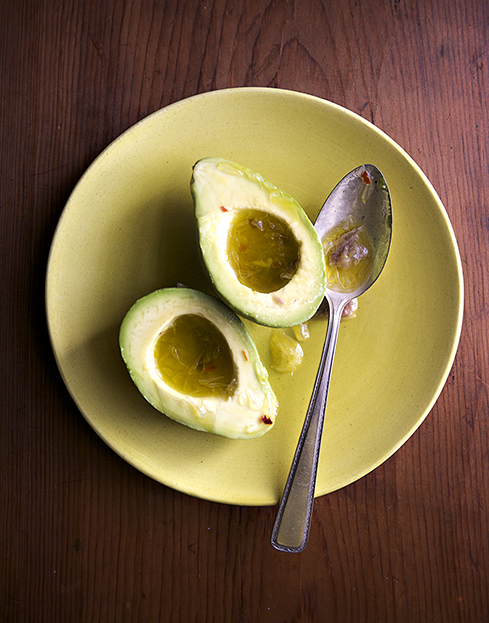
AVOCADOS WITH LEMON-SUPREME VINAIGRETTE
Slice the ends off of 1 lemon. Stand the lemon up on one end and cut off the rind and white pith, exposing the flesh. Working over a salad bowl, cut along both sides of each segment to release it from its membrane, letting it drop into the bowl. Add 2 minced anchovy filets, 1 pinch crushed red pepper flakes, and ¼ cup really good extra-virgin olive oil to the bowl. Season with salt and pepper. Stir well, mashing up the lemon segments with the back of a spoon to break them up. Slice 2 ripe Hass avocados in half lengthwise. Remove the pit and peel each avocado half. Spoon the vinaigrette into 4 avocado halves.—serves 2–4
CAULIFLOWER SALAD WITH GREEN OLIVES RADISHES & PARSLEY
serves 4–6
We serve this pretty vegetable salad—with its bright lemony vinaigrette, meaty olives, and crunchy, peppery radishes—on its own or with smoky grilled birds, meats, or fish.
1 clove garlic, minced
Juice of 2 lemons (about ¼ cup)
Salt and pepper
5–6 tablespoons really good extra-virgin olive oil, plus more for drizzling
1 head cauliflower, cored and broken into small florets
1 small bunch radishes, quartered or sliced
½ cup green olives, pitted and torn in half
1 handful fresh parsley leaves, chopped
Pinch of crushed red pepper flakes
Put the garlic, lemon juice, and salt and pepper to taste in a large bowl. Whisk in the olive oil. Taste the vinaigrette, adjust the seasonings, and set aside. Cook the cauliflower in a large pot of salted boiling water over medium-high heat until tender, about 4 minutes. Drain well, then add to the bowl with the vinaigrette. Gently toss, then let marinate at room temperature for 1 hour. Add the radishes, olives, parsley, and red pepper flakes to the cauliflower. Season to taste with salt and pepper. Drizzle each serving with a little olive oil.

ROMANO BEANS IN TOMATO SAUCE
We’ve both had terrific luck growing the flat, green Romano beans in our home gardens. Every spring we plant the “magic” seeds and by midsummer the stalks are so tall and vigorous, it seems they could keep growing clear up to the sky; a stepladder is the only way to reach the beans at the top. These are stewing beans—they need to simmer for a time to become tender, and we like ours soft.
Put 1 pound Romano beans, 2–3 cloves crushed, peeled garlic, 4 cups passata di pomodoro or strained tomatoes, ¼–½ cup extra-virgin olive oil, 2 sprigs fresh basil, ½ cup water, and salt and pepper to taste into a heavy, medium, nonreactive pot with a tight-fitting lid. Bring to a simmer over medium heat. Reduce the heat to maintain a gentle simmer. Stew the beans in the sauce, stirring occasionally, until they are very tender, 45–60 minutes. Adjust the seasonings. Serve the beans with lots of the flavorful sauce.—serves 6
STRING BEAN SALAD WITH HAZELNUTS & CREAM
serves 4
Most nuts benefit from toasting to bring out their rich, nutty flavor. Toast the hazelnuts for this salad in a 400° oven until golden brown.
1 pound string beans
⅓ cup heavy cream
2 teaspoons finely grated lemon zest
Salt and pepper
Juice of 1 lemon
½ cup toasted, skinless hazelnuts, coarsely chopped
Cook the string beans in a large pot of salted boiling water over mediumhigh heat until tender, about 8 minutes. Drain the beans, then rinse them under cool water. Put the beans in the refrigerator until they are cold. Combine the cream and lemon zest in a large bowl. Season with salt and pepper. Whisk in the lemon juice. The sauce will thicken, but it won’t curdle. Add the beans and hazelnuts to the bowl and toss well. Add a splash of water to loosen the sauce if it’s too thick. Adjust the seasonings. Serve cold.
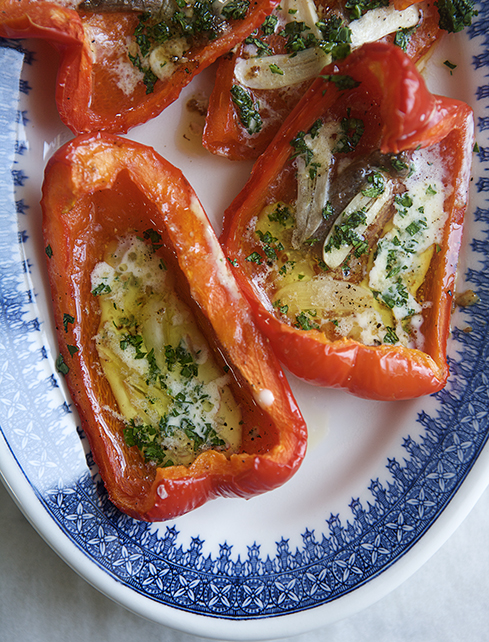
PEPPERS ROASTED WITH ANCHOVIES & BUTTER
serves 2–4
Each bite of these pretty cupped peppers is a mouthful of flavor. Gild the lily and add the cream.
2 medium red bell peppers, cored, quartered lengthwise, and seeded
4 anchovy filets
2 cloves garlic, thinly sliced
2 tablespoons butter, cut into pieces
Really good extra-virgin olive oil
Salt and pepper
2 teaspoons heavy cream, optional
1 tablespoon finely chopped fresh parsley leaves
Preheat the oven to 325°. Arrange the peppers flesh side up in a single layer in a shallow baking dish. Tear each anchovy filet in half and tuck one piece, along with 2 or 3 slices of garlic, in each pepper. Divide the pieces of butter evenly between the peppers. Drizzle the peppers with olive oil, and season to taste with salt and pepper. Go easy on the salt; the anchovies are good and salty. Roast the peppers until the flesh has softened but is not completely tender, 30–40 minutes. Remove the peppers from the oven. Drizzle with heavy cream, if you like. Scatter the peppers with parsley. Serve warm.
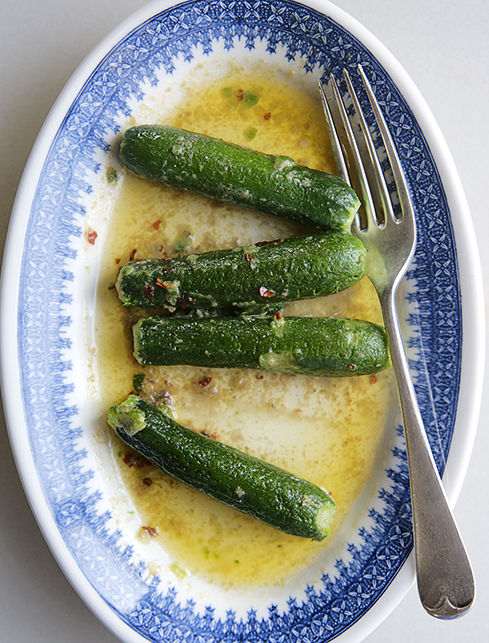
ZUCCHINI WITH SPICY ANCHOVY BUTTER
We first started serving this sauce years ago spooned over fat shrimp that had been grilled in their shells over hardwood coals. We’d peel and eat the shrimp, dipping them in the sauce, licking the deliciousness off our fingers. It was so addictive we found ourselves putting more sauce onto the plate so we could mop it up with hunks of warm bread. Why stop at shrimp? Now we spoon it on steamed spinach, roasted beets, or cooked vegetables like these.
Cook ½ pound baby zucchini in a medium pot of salted boiling water over medium-high heat until very tender but not falling apart, about 8 minutes. Drain. Return the empty pot to the stove. Reduce the heat to medium-low. Melt 6 tablespoons butter in the pot. Add 6 minced anchovy filets and 2 pinches of crushed red pepper flakes, swirling the pot. Add the zucchini, turning them to coat. Season with a little salt, if you like. Serve warm.—serves 4
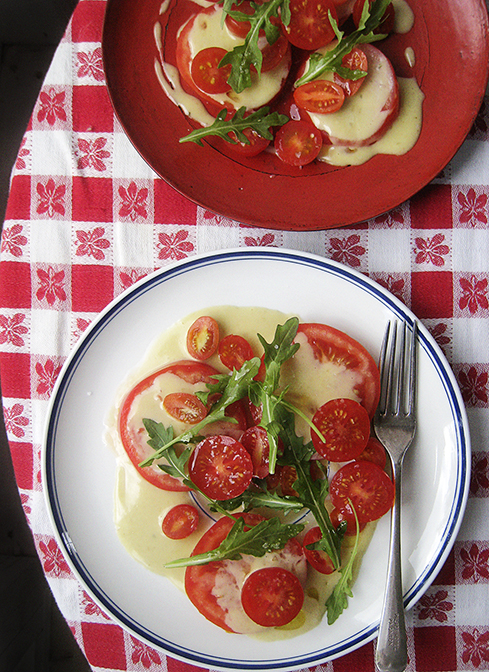
TOMATOES WITH TONNATO SAUCE
serves 4–6
We love this sauce so much we spoon it on everything—boiled potatoes, grilled chicken, steamed summer vegetables hot or cold—but our favorite is this beautiful ode to tomato season.
FOR THE TONNATO SAUCE
2 large egg yolks
Salt
Juice of ½ lemon
½ cup canola oil
½ cup really good extra-virgin olive oil
1 small can tuna packed in olive
oil (about 2 ounces), preferably Italian
3 anchovy filets
1 tablespoon capers
1 clove garlic
Pepper
FOR THE TOMATOES
2 pounds tomatoes of various types and sizes, cored and sliced or halved
Arugula leaves
Salt and pepper
Really good extra-virgin olive oil
For the tonnato sauce, whisk together the egg yolks, a pinch of salt, and half of the lemon juice in a medium bowl. Combine the canola and olive oils in a measuring cup with a spout. Whisking constantly, add the oil to the yolks, about 1 teaspoon at a time. The sauce will thicken and emulsify. After you’ve added about ¼ cup of the oil, you can begin to slowly drizzle in the remaining oil as you continue to whisk, until you have a thick glossy mayonnaise. Transfer the sauce to a small bowl.
Purée the tuna, anchovies, capers, and garlic in a food processor until it is a smooth paste. Add a little olive oil to help the process. Use a rubber spatula and press the tuna paste through a sieve into the mayonnaise. Season to taste with the remaining lemon juice and salt and pepper. Transfer to a covered container and refrigerate until ready to use. The sauce will keep for up to 1 week in the refrigerator.
For the tomatoes, spoon some of the sauce onto individual plates or a platter and arrange the tomatoes on top. Spoon more sauce over the tomatoes. Scatter the arugula on top. Season with salt and pepper and a drizzle of olive oil.

TOMATOES STUFFED WITH TUNA SALAD
makes 4
This tuna salad will keep in the refrigerator for a couple of days, but the flavors are best at room temperature, when the salad has just been made. Tomatoes should always stay out of the fridge. The cold saps their flavor and texture.
4 ripe tomatoes
Salt
Two 5-ounce cans tuna packed in olive oil, drained
1 large handful fresh parsley leaves, chopped
4 scallions, thinly sliced
3 tablespoons really good extra-virgin olive oil, plus more for drizzling
Juice of ½–1 lemon
Pepper
1 hard-boiled egg, peeled and coarsely chopped
Slice off the top quarter of each tomato. Use a small spoon to carefully scoop out and discard the interior pulp without piercing the tomato walls. Sprinkle the inside of each tomato with a pinch of salt, then turn the tomatoes upside down on a paper towel to drain.
Put the tuna in a medium bowl, flaking it with your fingers or a fork. Fold in the parsley, scallions, olive oil, and lemon juice. Season with salt and pepper. Add the hard-boiled egg, mixing gently. Fill each tomato with some of the tuna salad. Drizzle the tomatoes with olive oil before serving.

POTATOES WITH ANCHOVIES & RED PEPPER FLAKES
Put 2–3 russet potatoes in a medium pot, cover with cold water, and add a generous pinch of salt. Bring to a boil over high heat, then reduce the heat to medium. Simmer the potatoes until tender when pierced, 30–40 minutes. Drain. When cool enough to handle, peel the potatoes. Meanwhile, heat ¼ cup extra-virgin olive oil, 6 minced anchovy filets, and 1 teaspoon crushed red pepper flakes in a small saucepan over medium heat, stirring often, until the oil is very warm and the anchovies have dissolved, 3–5 minutes. Slice the warm potatoes into thick rounds and arrange them on a serving platter. Spoon the warm oil over the potatoes.—serves 4
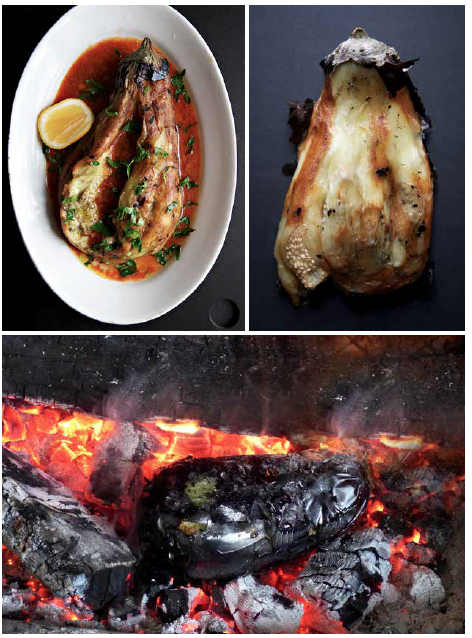
EGGPLANT COOKED IN THE COALS
Prepare a hardwood charcoal fire. When the coals are medium hot, put 4 small or 2 medium whole eggplant directly on the coals. Cook the eggplant, turning them as the skin blackens and turns papery, until they begin to collapse and the flesh is soft, 5–15 minutes depending on the size of eggplant and the heat of the coals. Transfer the eggplant to a wire rack on a sheet pan. When they are cool enough to handle, peel off the blackened skin, leaving the flesh whole and the stem end intact. Return the eggplant to the wire rack and let them drain for about 30 minutes before serving. —serves 4–6
EGGPLANT WITH SMOKY TOMATO & HARISSA SAUCE
serves 4–6
There are many sensuous flavors in this sauce. We sometimes spoon it over chicken or fish (or abandon ourselves and just eat it by the spoonful).
FOR THE SAUCE
2 small ripe tomatoes
3 anchovy filets, minced
1 clove garlic, peeled and minced
1 teaspoon harissa
1 teaspoon red wine vinegar
2 tablespoons extra-virgin olive oil
FOR THE EGGPLANT
4 small or 2 medium eggplant, charred, peeled, and drained (see Eggplant Cooked in the Coals)
Extra-virgin olive oil
Salt
1 small handful fresh parsley leaves, chopped
1 lemon, quartered
For the sauce, grill the tomatoes over a hot charcoal fire until the skin blackens and splits, and before the tomatoes collapse, 2–3 minutes. Put the tomatoes in a sieve over a bowl. Press the juice and flesh through; discard the skin. Put ¼ cup of the pulpy tomato juices in a medium bowl. Add the anchovies, garlic, harissa, and vinegar. Stir in the olive oil. Adjust the seasonings. For the eggplant, spoon half the sauce onto a serving platter. Place the eggplant on top. Spoon the remaining sauce over the eggplant. Let the flavors meld for a bit. Drizzle with olive oil. Season with salt. Garnish with parsley and lemons and serve with hunks of warm country bread or grilled flatbread, if you like.
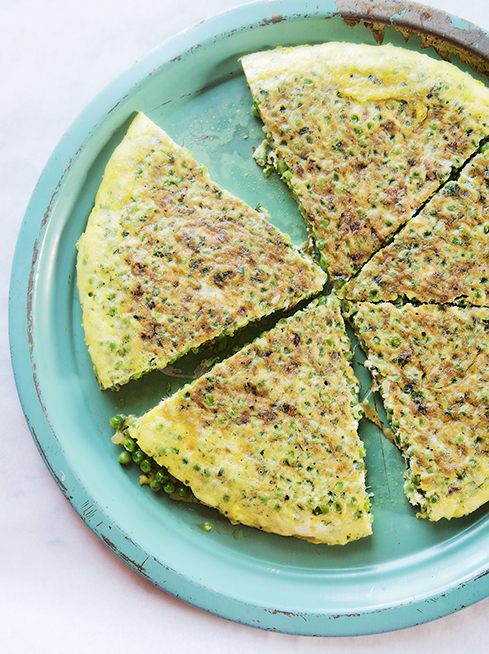
GREEN PEA & PROSCIUTTO FRITATTA
serves 6
We usually have a dozen eggs and a hunk of parmigiano stashed in our fridge. And sometimes, the only green vegetable we’ve got on hand is a bag of frozen peas. This fritatta is a staple at Canal House when we’re hungry and need to scrape together something good to eat with very little.
4 tablespoons extra-virgin olive oil
1 small onion, finely chopped
4 ounces (6 thin slices) prosciutto, coarsely chopped
Salt and pepper
2 cups peas, blanched if fresh; defrosted if frozen
1 large handful fresh parsley leaves, finely chopped
1 cup finely grated parmigianoreggiano
6 eggs
Heat 2 tablespoons of the oil in a large, well-seasoned cast-iron or nonstick skillet over medium heat. Add the onions and cook until they begin to soften, about 5 minutes. Add the prosciutto and cook until the onions are soft, 5–8 minutes. Season with salt and pepper (the prosciutto is salty so be sparing with the salt and lavish with the pepper, if you like). Using a rubber spatula, scrape the onions and prosciutto into a large bowl. Wipe the skillet clean with a paper towel and set the skillet aside.
Add the peas, parsley, and parmigiano to the bowl with the onions and stir well. Crack the eggs into a medium bowl, add a pinch of salt, and beat the eggs well. Pour the eggs into the bowl with the peas, stirring until well combined. Heat 1 tablespoon of the oil in the reserved skillet over medium heat. When the skillet is hot, pour in the egg mixture, smoothing the top with a spatula. Cook until the bottom of the fritatta is golden and set, 10–12 minutes. Slide the fritatta out of the skillet onto a large plate. Add the remaining 1 tablespoon oil to the skillet, swirling it to coat.
Carefully invert the fritatta into the skillet, browned side facing up. Return the skillet to medium heat. Continue cooking the fritatta until the bottom is golden, about 5 minutes. Slide the fritatta onto a serving platter. Season with a little salt. Slice into wedges. Serve warm or room temperature.
ZUCCHINI PANCAKES
makes about 12
When zucchini season hits, farm market bins bulge and the zucchini plants in our gardens start producing like they’re growing in Jurassic Park. That’s when we make these pancakes. They go as fast as the zucchini come on.
4 medium zucchini
Salt
8 eggs
1 cup finely grated pecorino
½ cup all-purpose flour
1 bunch scallions, thinly sliced
1 large handful fresh parsley leaves, finely chopped
1 clove garlic, minced
Finely grated zest of 2 lemons
Big pinch of crushed red pepper flakes
Pepper
Olive oil
Working over a colander set over a large bowl, grate the zucchini on the large holes of a box grater into the colander. Generously sprinkle salt over the grated zucchini and toss with your hands. Set the zucchini aside to drain for 30 minutes. Discard the liquid. Squeeze the zucchini by the handful to get as much liquid out as possible.
Crack the eggs into a large mixing bowl and lightly beat them. Add the zucchini, pecorino, flour, scallions, parsley, garlic, lemon zest, and red pepper flakes. Season with salt and pepper. Gently stir until well combined. Heat 1 tablespoon of olive oil in a heavy large skillet over medium heat until hot but not smoking. For each pancake, spoon about ¼ cup of batter into the skillet at least 2 inches apart. Cook until little holes appear on the surface and the cooked side of the pancakes—lift the edges to check—are golden brown, 1–2 minutes. Turn the pancakes over and cook until the second side is golden brown, 1–2 minutes. Transfer as done to a wire rack. Repeat with the remaining batter, making about 12 pancakes. Add more oil to the skillet as needed. Serve warm.
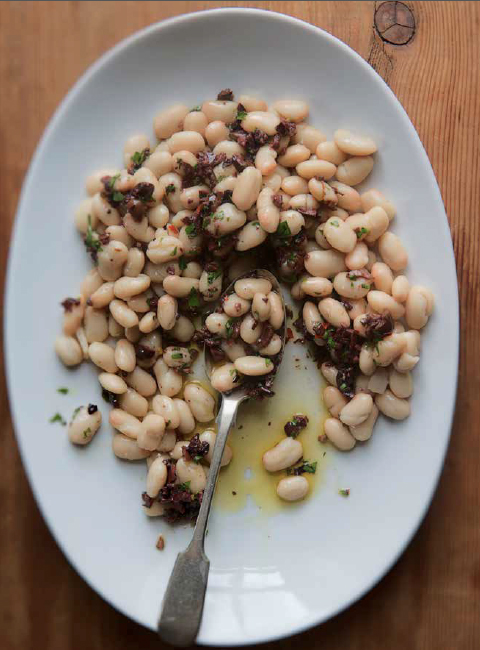
WHITE BEANS WITH SPICY BLACK OLIVE VINAIGRETTE
serves 2–4
When we use canned beans, we like to give them a little love before we dress them. Drain them into a sieve, give them a good rinse under cold running water, then drain well and toss with a drizzle of olive oil and season with salt. Then go in with your dressing.
½ clove garlic, minced
¼ cup finely chopped pitted black olives
1 tablespoon finely chopped parsley leaves
1 tablespoon red wine vinegar
¼ cup really good extra-virgin olive oil, plus more for drizzling
Pinch of crushed red pepper flakes
Salt and pepper
2 cups cooked cannellini beans
Stir together the garlic, olives, parsley, vinegar, olive oil, and red pepper flakes in a medium mixing bowl. Season with salt and pepper. Add the beans and toss gently to coat. Taste and adjust the seasonings. Transfer to a serving platter and drizzle with more olive oil before serving.
COOKING DRIED BEANS
Look for the “Best Used By” date when buying a package of dried beans. The fresher the beans, the more quickly they’ll cook. Cook a whole pound, it will yield 4–5 cups of beans. Add them to salads or just serve them as a side dish dressed with a little olive oil and fresh lemon juice. Cooked beans freeze beautifully.
TO COOK BEANS: Put the dried beans in a large pot and add enough cold water to cover by 4 inches. Cover and bring to a rolling boil over high heat. Turn off the heat and allow the beans to soak undisturbed for about 1 hour. Drain the beans and add fresh water to cover by 2 inches. Bring to a gentle boil over high heat, then reduce the heat to medium-low and cook until the beans are tender. It can take anywhere from 1–3 hours, depending on the freshness of the beans. Test them after an hour to see how they are progressing. Add salt and let them cool in their liquid.

Lunch in Palermo